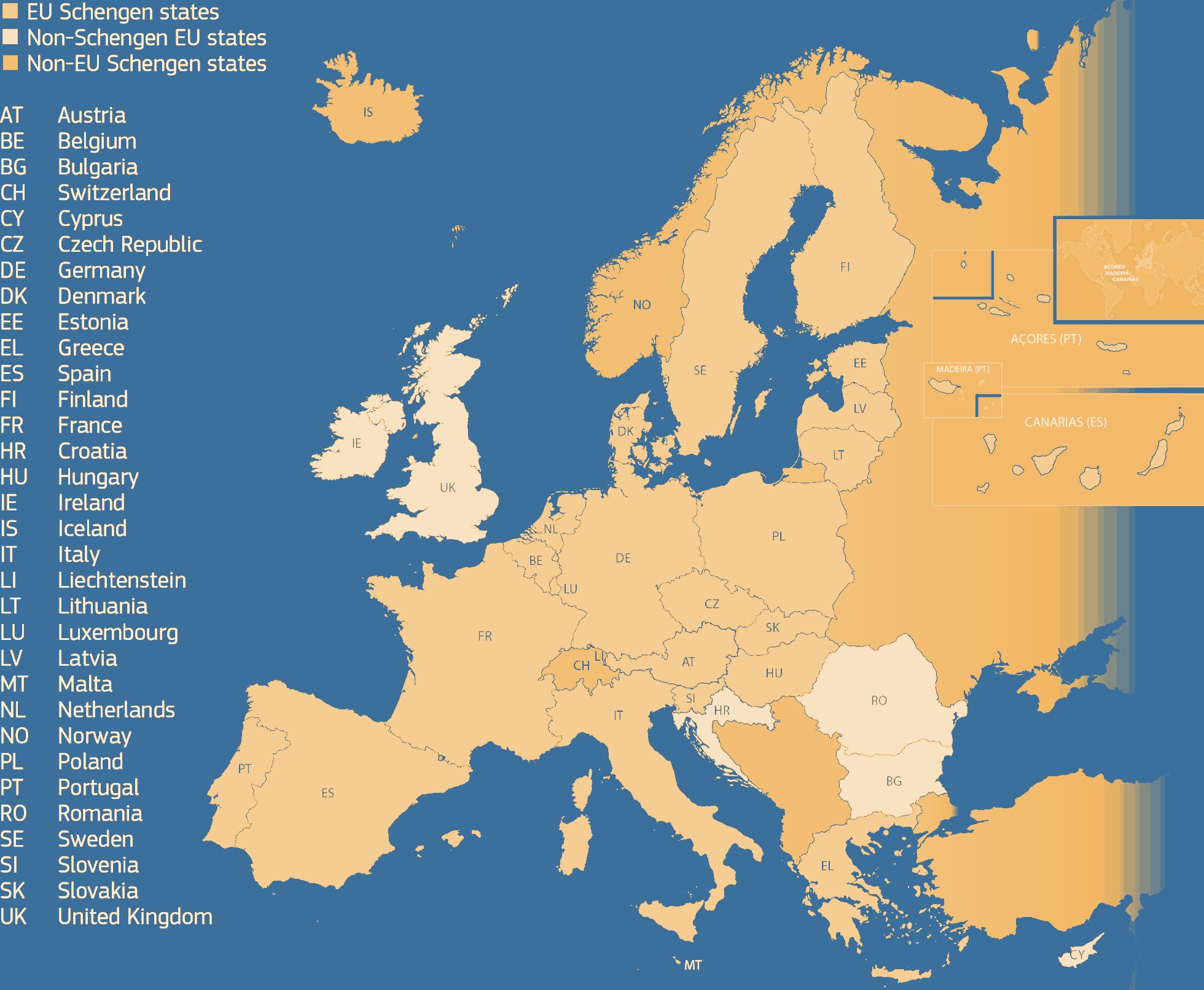Schengen
Visa Insurance
What Countries Are Part of The Schengen Area?
While many people think that the European Union and Schengen Area are coterminous, this is actually not the case. That is to say, some members of the European Union are not signatories of the Schengen Agreement, and require separate visas for entry. Meanwhile, some countries are not members of the European Union, but are signatories of the Schengen Agreement. A notable example of the former is the United Kingdom, and a notable example of the latter is Norway.
The following map shows this distinction:

Who Needs a Schengen Visa?
The Schengen Visa is available to citizens of non-member countries who wish to travel to one of the member countries for leisure or business for 90 days or less within a 180 day period. While US citizens, and nationals of many other countries, do not need to apply for a Schengen visa before arriving in Europe, they are required to present a passport that is valid for at least 90 days when they first arrive in the Schengen area.
A complete list of countries whose citizens must obtain a Schengen Visa in order to enter any member country of the Schengen Area is as follows:- Afghanistan
- Algeria
- Angola
- Armenia
- Azerbaijan
- Bahrain
- Bangladesh
- Belarus
- Benin
- Bhutan
- Bolivia
- Botswana
- Burkina Faso
- Burma/Myanmar
- Burundi
- Cambodia
- Cameroon
- Cape Verde
- Central African Republic
- Chad
- China
- Comoros
- Congo
- Cote D’ivoire
- Cuba
- Dem. Rep. Of Congo
- Djibouti
- Dominican Republic
- Ecuador
- Egypt
- Equatorial Guinea
- Eritrea
- Ethiopia
- Fiji
- Gabon
- Gambia
- Ghana
- Guinea
- Guinea-Bissau
- Guyana
- Haiti
- India
- Iran
- Iraq
- Jamaica
- Jordan
- Kazakhstan
- Kenya
- Kosova
- Kuwait
- Kyrgyzstan
- Laos
- Lebanon
- Lesotho
- Liberia
- Libya
- Madagascar
- Malawi
- Maldives
- Mali
- Mauritania
- Mongolia
- Morocco
- Mozambique
- Namibia
- Nepal
- Niger
- Nigeria
- North Korea
- Northern Mariana’s
- Oman
- Pakistan
- Papua New Guinea
- Philippines
- Qatar
- Russia
- Sao Tome And Principe
- Saudi Arabia
- Senegal
- Sierra Leone
- Somalia
- South Africa
- Sri Lanka
- Sudan
- Suriname
- Swaziland
- Syria
- Tajikistan
- Tanzania
- Thailand
- Timor-Leste
- Togo
- Tonga
- Tunisia
- Turkey
- Turkmenistan
- Uganda
- Uzbekistan
- Vietnam
- Yemen
- Zambia
- Zimbabwe
Schengen Visa Insurance Requirements
While a complete list of requirements, as well as an overview of the entire Schengen Visa application process, can be found here, there is one requirement that merits special attention: insurance. Insurance is one of the most commonly overlooked requirements but if you neglect it you do so at your peril: that is because before the visa can be issued, applicants must show proof that they have adequate health insurance coverage that will meet the requirements of the Schengen Visa. Fortunately, those requirements are easy to satisfy:
- Minimum coverage shall be €30 000 (equivalent to $50,000 USD)
- Coverage must be valid within the entire Schengen region and for the full duration of stay
- The policy must cover any expenses which might arise in connection with emergency medical treatment, hospitalization, and/or repatriation (up to and including that of remains in the case of death)
All our plans issue a Visa Letter within one hour of purchase.
While the above is a good overview, it always pays to check with your local consulate or embassy about any specific health insurance minimums that they may have, as these minimums may vary by member state.
If you are looking to apply for your Schengen Visa and need health insurance, we recommend the Atlas Travel plan, Student Secure plan or the Europe Travel plan. All three of these policies provide coverage throughout the Schengen region and will meet the stated requirements above. You will also have instant access to a letter of coverage that you can show to the embassy or consulate in order to prove that you have adequate health insurance coverage.
Please note: to meet these insurance requirements, travelers will need to provide a letter from their insurance company that confirms that coverage meets the minimum level of coverage. The duration of coverage will need to match the period of travel stated on your visa.
What Countries Accept the Schengen Visa?
There are 26 countries that accept the Schengen visa, and of these, 22 are part of the European Union, and the other 4 are non-EU members. One notable exception, for example, is Ireland: while a member of the European Union, it is not a signatory of the Schengen Agreement (and therefore has its own visa application process). For this reason you should pay close attention to this list of Schengen countries.How to Apply for a Schengen Visa
As millions of travelers a year can attest, the Schengen visa has made traveling among its 26 countries easy. That is because a Schengen visa allows you to travel freely to and between each member country without a systematic process of custom controls or passport checks. This makes travel within the Schengen Area as hassle-free as possible. So how do you get in on the action? Read on to find out what the advantages of the Schengen visa are, who needs ones, and what steps you need to take to get it.Who is Eligible?
The Schengen visa is available to travelers coming to the Schengen area for the purpose of leisure, tourism, studying, visiting family, or business for up to 90 days in a 6 month period. If you have a multiple-entry visa, you will be able to leave and return as many times as you’d like within the 6 month period, but the total duration of time in the Schengen area cannot exceed a total of 90 days in a single six-month period.
While the nationals of many countries, do not need to apply for a Schengen visa before arriving in Europe, citizens from these countries are required to obtain a Schengen Visa in order to enter any member country of the Schengen Area.Understanding the Process
-
When to Apply To obtain a Schengen visa, you can apply no earlier than 3 months in advance of your arrival. Since the application process can take up to 15 days by itself — and can be delayed by up to 60 days if further investigation warranted — you should be sure to plan ahead.
-
Where to Apply If you will be traveling to one country in particular, you will apply for a Schengen visa in that country. If you plan on traveling to multiple countries, you'll want to apply to your primary destination country. If there is no primary destination, you should apply to the country you will enter into first.
-
Documentation Needed You will need to
- complete the visa application form and attach a good quality passport photograph in the dimensions of 35x45mm.
- The passport you submit should be valid for atvalid at least 90 days after your visa expires and cannot be more than 10 years old.
- pay the required visa fee as well as any secondary service fees (if applicable)
- submit proof of travel medical insurance which covers any expenses that might be incurred in connection with emergency medical treatment, hospitalization, and/or repatriation (up to and including that of remains in the case of death)
- be prepared to provide any other documents related to 1) the purpose of your stay (e.g., your letter of acceptance to the school at which you will study), 2) evidence of means of support during your stay, and 3) and your accommodations.
US Citizens Traveling to Schengen Countries
If you're a US citizen who'll be traveling to the Schengen Area, you're in for a happy surprise, because: traveling to much of Europe is easier than you expected. Thanks to the Schengen Agreement, US citizens will be able to travel freely to and between all 26 of the member countries without having to present their passport each time.
What documents should you bring upon entry?
While US citizens are usually not subject to close scrutiny, you should still have access to the following documents in case they're requested during at your point of entry into Europe or at any spot checks that you may encounter along the way:
